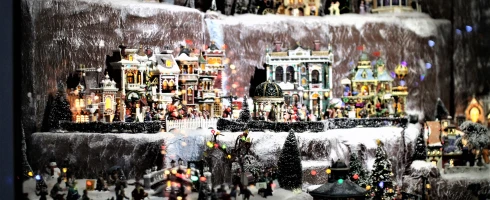After the success of last year’s Best Belconnen Christmas lights, I had to get back out and again experience one of the things that really makes this time of year feel like Christmas to me. Here are my Top 3 picks for 2016!
Why I’m a Belconnen candidate in the ACT election
22 Aug
Next week marks In The Taratory’s fifth birthday.
It’s a fitting time for the blog to officially take a hiatus.
Here’s why.
The Slip Lane, The Street Theatre*
28 Jul* I attended The Slip Lane as a guest of the Aspen Island Theatre Company.
It’s a rare occasion that I leave the theatre knowing less about the play I’ve just seen than before I walked in. But that’s the case with locally-based The Slip Lane by Julian Hobba.
Divorcee Matthew (Dene Kermond) lives in four-bedroom house Palmerston – yep, this play is set in Gungahlin. And Matthew has been mulling over a suggestion for a road improvement – a slip lane at Gundaroo Drive and Gungahlin Drive (Extension).
Matthew is so enthused with his suggestion, he heads to Access Canberra – the Service Centre in Gungahlin, no less – to wait to provide his suggestion which falls on deaf ears. While he waits, he meets Missy (Clare Moss) who lives near Percival Hill (a walk I’ve reviewed!) (I presume she’s in Crace). She’s there to complain about a creature she’s seen at night that has bulging red eyes and three heads (and she gets excellent service, with rangers continually visiting but finding nothing). Matthew is happy to come check out what’s going on and allay her concerns – and perhaps romance is on the cards, too.
Matthew ventures out into the nature park armed with Missy’s child’s toy sword. I’m convinced that this creature is going to turn out to be Chris the Sheep and I can continue to relate and enjoy what initially feels like a very Canberran play.
Alas, it’s not Chris the Sheep. It’s a demon and it really does have three heads and bulging red eyes.
Mind you – this all happens in the first 20 minutes of the 90 minute play. What follows next is the demon’s attempt for Gungahlin to secede, Hutt River Province-style; a campaign to make the slip lane reality; an approach to make Matthew a successful Senate candidate in what’s a nod to preference whisperer Glenn Druery; a murder; onesies; and garden gnomes crying blood.
The play swings from light humour to very dark themes; sincere moments to comedic violence. Sure, it’s absurdist – but it’s also overwhelming. The four actors fill the space and the themes, and on top of all their lines in the 90 minute, no-interval play, each delivers at least one solid soliloquy for reasons which I can’t quite grasp.
I’m really impressed with the use of digital backdrops to enhance each scene. Access Canberra really does look like Access Canberra; I can imagine the dripping blue light feature wall in any home built in the last 5 years; and Percival Hill is, I think, a grainy image of Percival Hill which makes it feel quite immersive. It, together with the clever use of lighting, helps centre a play which otherwise tries to do too much.
Date: Thursday, 28 July 2016
Cost: I attended as a guest; tickets are $32-38
Want more? Purchase tickets at thestreet.org.au. It’s on until Sunday evening.
Movenpick, Kingston Foreshore*
22 May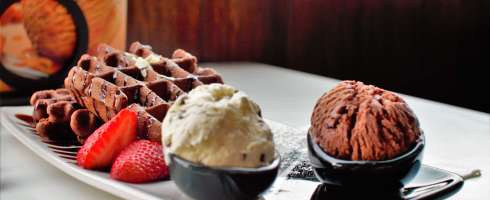
* I attended Movenpick as a guest
For the uneducated (like I was), Movenpick is an international ice cream brand. It’s one of those franchises people are obsessed with: queuing up outside for hours, sampling all the flavours, and coming back the very next day to try it all again.
And that’s the story of Siddharth Mahabal and Aneeta Singh. While living in New Zealand they didn’t just eat Movenpick but they lived it, and on moving to Canberra figured if there wasn’t a store here already then they had to work hard to bring one here – including opening it themselves.
They did just that. At the launch of Movenpick we heard from the head office how the husband and wife team would regularly contact Movenpick to ask them to consider opening a store in Canberra. They were nothing if not persistent! The good news – for Siddharth and Aneeta, as well as for all of Canberra – is that it worked.
Canberra’s very first Movenpick store is located on the still-expanding Kingston foreshore, down the end where you’ll find Molto Italian. It’s a corner store, luxuriously fitted out with leather couches in the traditional Movenpick colours of black, red and white and curved edges everywhere I look. It’s classy and homely.
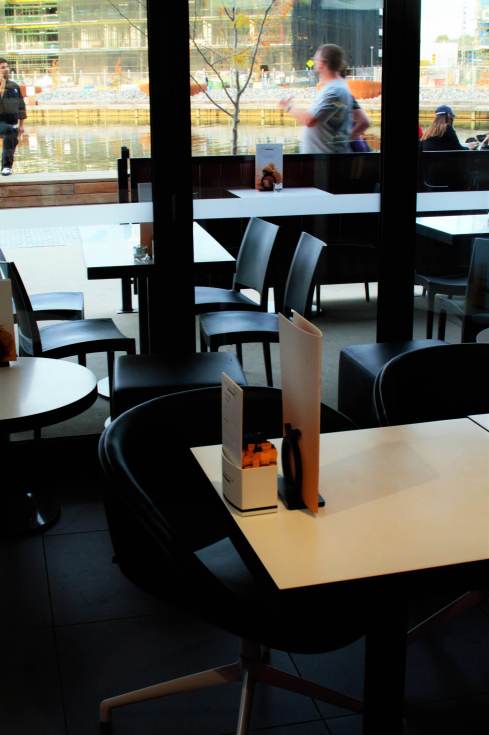

One of the best parts of Kingston foreshore is being close to the lake. Movenpick’s taken the bold step of having an outdoor eating area. Given Canberra winters average about eight months, I was skeptical whether this would be successful but Movenpick has been able to stretch out the awning to provide a covered area and they also have these beauties:
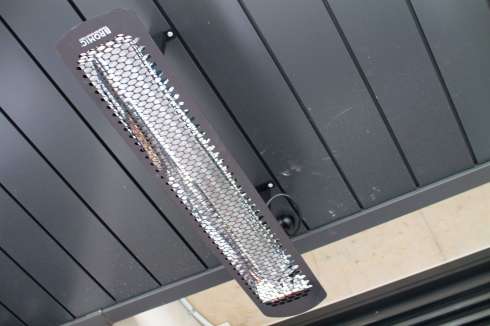
They work a treat and have me shrugging off my jacket.
But we’re here for the ice cream! So what’s on offer?
The first thing you need to know is that Movenpick offers free tasting of all its flavours. And there are a lot. And some of the flavours you can’t quite properly grasp until you taste them, so don’t be shy. I try blueberry cheesecake, cinnamon, raspberry sorbet doubled with Swiss chocolate to make a Cherry Ripe-style duo, caramelita, espresso (as a non-coffee drinker this almost blew my head off – the flavour is strong), maple walnut, mint chocolate, chocolate brownie… you get the idea.
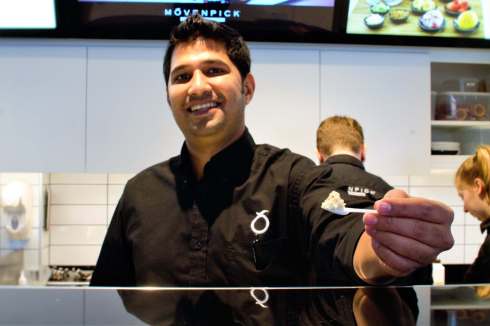
Siddharth isn’t just the owner of Movenpick Kingston, but probably one of Movenpick’s greatest ambassadors! And he consistently serves with a smile, even at my 10th tasting.
The process of creating Movenpick ice cream is something of a feat. Ingredients are sourced from all of the world – Madagascan vanilla pods, cocoa beans from Venezuela – and brought to Switzerland where the ice cream is prepared centrally, before being shipped to its stores around the world. You can’t doubt the Swiss for wanting to achieve consistency in quality product, even if I do wonder a bit about overall efficiency.
Movenpick ice creams are creamy. Really creamy. And the flavours come through strongly – they use natural ingredients and there are no artificial additives, colours or flavours – just like our own local Frugii. My favourite flavours are cinnamon and blueberry cheesecake (these are two separate flavours), but the tasting helps me uncover flavours I was convinced I wouldn’t really like and love: caramelita (with both caramel ripple and caramel bits) and the white chocolate, too.
I start with a double serve of cinnamon and blueberry cheesecake in a cone. But it turns out to be that my only love is sprung from my only hate. Or, to be less dramatic, the delicious blueberry cheesecake (which I love) is slated to replace the cinnamon ice cream (which is beyond devastating!). If you are reading this, Movenpick head honchos, you are making a mistake. The cinnamon is so, so good. (If you think you might like even kind of like the cinnamon I urge you to get in quick before it’s gone forever!)

Cinnamon and blueberry cheesecake. The cones are made on site.
While I’ve been on my Charlie and the Chocolate Factory-esque taste of everything on site, Boyfriend has gone ahead and ordered a plate of the Movenpick macarons: macaron shells filled with ice cream and served with cream and a dash of chocolate sauce. It’s pretty darn decadent with chocolate, salted caramel and pistachio ($12.95).
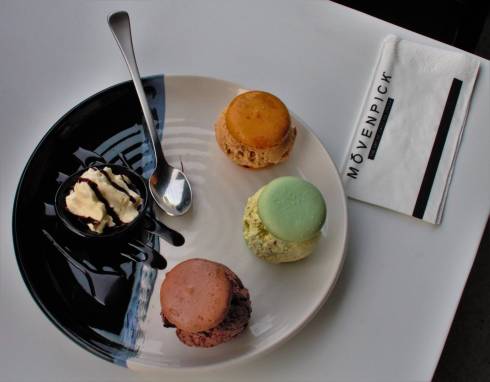
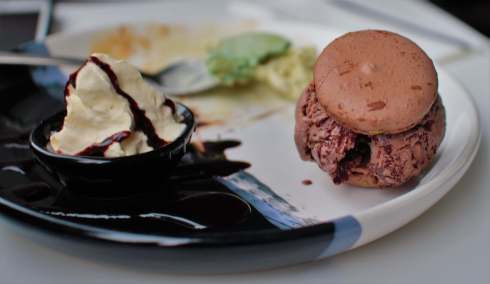
I think this is one of the best value for money offerings that Movenpick has: the macaron shells are high quality and the servings of ice cream sandwiched in each is essentially three different scoops. I’m not sure what it is about the pistachio but I’m not a fan and neither is Boyfriend – but otherwise the tastes are very, very good.
(Do you like the plates? They’re by Robert Gordon Australia.)
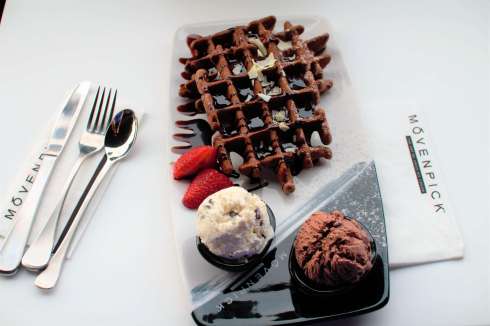
Siddharth insists we try the chocolate waffles. These, along with the apple strudel, are items which obviously have a particular appeal during winter. The waffles are prepared on site according to the Movenpick recipe and they’re made to order so they come out hot and fresh with another two big serves of ice cream and brilliantly-red, sweet strawberries with lashings of chocolate sauce.
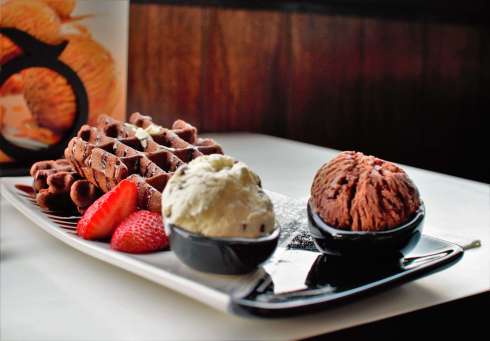
This is another very decadent dessert. The waffles are crisp on the edge and overall very cakey in texture. Noting most of my waffle experience has been with frozen ones that you microwave that are essentially hollow inside, this takes me by surprise. Keeping the ice cream and waffles separate keeps the ice cream from melting and lets you choose how you want to eat them, but my recommendation is to pile the ice cream on the waffle so you get the cakey bits, the crunchy bits, the cold bits and hot bits all in one mouthful. Yum! (Save the strawberries until last so you can end feeling healthy.)
While Frugii will always be #1 for me, I’m impressed with what Movenpick has to offer, especially given it’s a franchise. The personal effort from Siddharth and Aneeta can be felt throughout the store and the ice cream flavours are spot on.
(Please keep the cinnamon ice cream, Movenpick. It really is very, very good.)
Date: Saturday, 7 May 2016
Where: Kingston Foreshore, 43 Eastlake Parade
Cost: I attended Movenpick Kingston as a guest; we paid for the ice cream sandwich macarons
Worthwhile factor: Highly worthwhile
Value for money: Reasonable: as you might expect from a product with ingredients sourced from around the world and centrally prepared in Switzerland, a single scoop is on the upper end for cost – but it is very high quality.
Want more? Check out their Facebook page for more.
Cork Street Cafe, Gundaroo
8 May
Forty minutes from Canberra, Gundaroo is an historic village where there’s a lot to see, eat and drink along its main street – Cork Street. Along the street is the Gundaroo Pub and further up is Grazing and Capital Wines.
Today we’re at the the Cork Street Cafe, an institution on the site of the old police station across the road from the pub. The cafe proper is in the horse tables; a barn of stones and bricks.
Gallipoli 2015: a reflection
24 Apr
In 2015 I was one of 10,500 Australians and New Zealanders who were lucky enough to be successful in the ballot to attend the Gallipoli 2015 commemorations. I had always planned to write about it, but life quite literally got in the way. Here are a few reflections of what it was like to be there, to step on that land.
My best friend and her father have plans to go to Gallipoli in 2015 for the 100th anniversary commemorations. For me, it’s something I’ve never thought about. Her beautiful father passes away in 2013 and her trip to Gallipoli remains just as important, but for different reasons. She explains it better than I ever could in this poem here.
We hear about the ballot in 2013; a few thousand double passes for Aussies and Kiwis. We apply separately to increase our chances, and in early 2014 learn we’ve both missed out. We’re on a waitlist. Of the 40,000 who’ve applied we’re high up the list, but far enough from the top that it still seems impossible.
In early November she gets the news: she’s got the double pass and we’re going. A few weeks later I get the same news, but return my double pass into the pool: I’m going with my friend. The next few weeks are a frenzy of booking flights, accommodation and a tour (we can’t get in the site without it) and providing all the details to the Government so that we can get our passes and be confirmed.
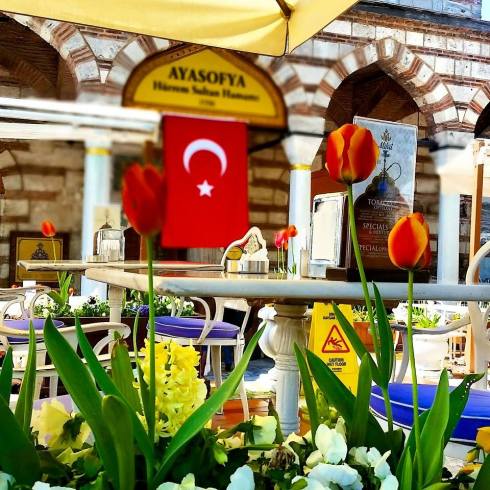
We arrive in Turkey on April 22 without incident. Istanbul is teeming with Australians (and a few New Zealanders) – 10,500 is a lot of people. Our tour pre-briefs us in the evening of April 23 and advises we bring plenty of snacks and drinks; it’s not clear what will be available onsite. We get a hoodie – it’s going to be cold – and wake up near dawn to depart for Gelibolu.
It’s just before midday when we arrive at holding site of Kabatepe. We walk through numerous checkpoints – maybe three – and our bags go through machines like you see at airports. My pass states my full name and my passport number and the barcode gives me access to the Dawn Service and Lone Pine. It needs to be worn at all times. While standing in line we’re surprised to see Minister for Veterans’ Affairs Michael Ronaldson greeting us as we arrive for a good half hour.
The holding site is just that: a holding site. Security is paramount and everything is followed in a methodical way. We’re one of the first few buses to arrive and the expectation is that we wait until almost every bus has arrived. Some food is available as well as plenty of memorabilia. Friends of mine who I met on Young Endeavour back in 2004 arrive and become fast friends with my friend.
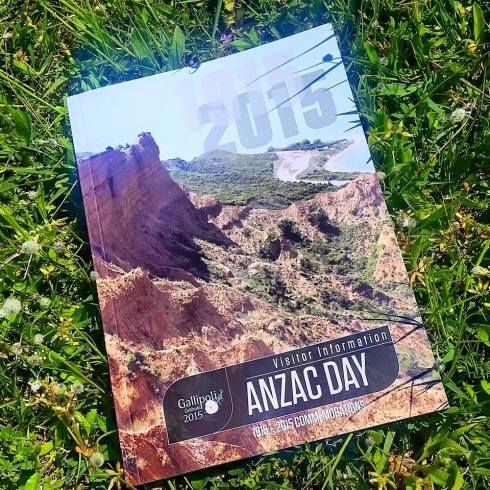
The area around us is flat and the shore isn’t steep; I find it hard to imagine how hard it might have been for the ANZACs in such calm and smooth surroundings, but later learn that this is essentially the site that they had planned to arrive at – not the site that became ANZAC Cove.
The wait is close to five hours – and even then we are released in stages, groups of bus numbers. We’re called comparative early and begin the trek down the long road to ANZAC Cove.

Walking to ANZAC Cove
The mood has been a warm one but sombre, and our walk is quiet. The landscape to our right gets steeper and more hilly. Every so often we spot a movement in the trees or behind a hill. They are Turkish soldiers with weapons. We remark that the few we’re seeing gives way to just how many we’re not seeing. Quite honestly, I’ve never felt more protected.
At the commemorative site there are more security checks and then we’re in. The site has been enormously expanded on previous years to fit the maximum safe number of persons. It’s late afternoon but we’re advised that people will be arriving at the site up until 3am. There is large stadium seating around the site and also a grassy hill where plenty of people are already lying down in their sleeping bags. We make a quick decision to sit in the front row of the front left stadium seating in the corner: restricting our view in some ways, but placing us next to the dignitaries’ entrance, the side of the stage and, movingly, the shore.
Settled in, it’s the first opportunity we have to look around and I feel foolish for my earlier thoughts about the landscape. The cliffs are steep and rocky and loom over us, lit by the setting sun.

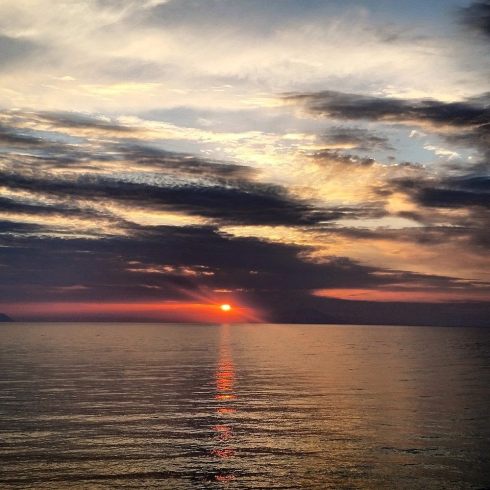
The sun glows red as it slips into the ocean and the warmth is gone, together with music that kept spirits bright into the night. There’s little wind but it’s a cold night and we’re soon ensconced in our sleeping bags, with our Gallipoli beanies (issued in a pack at an earlier checkpoint, together with commemorative booklets, a biodegradable rubbish bag and ponchos) on and the garish hoodies issued by our tour companies on.
Documentaries play through the night and I learn things I’ve never really understood or appreciated. The waves lap against the shore and the tranquility, the lack of distracting chatter, actually makes it easier to imagine the sound of gunfire and scrabbling around the shore. People arrive steadily right through the night, and those who were sleeping on the grass are all now standing tightly.
Before dawn we’re treated to clips of the ceremonies around the world, including every Australian city except Canberra (I know!). And then the waves become louder, as if there were landing boats within them, and William Barton pierces the silence with a didgeridoo performance followed by a Maori call to gathering.
The Chief of the Australian Defence Force tells us that it was here that the ANZAC legend was born at great cost and the reality of war was revealed, followed by an address by NZ Prime Minister John Key and a quotation shared from Mustafa Kemal Ataturk – who commanded critical forces during the Gallipoli campaign and was later President of the Republic of Turkey – that those sons who lost their lives lie in a friendly country, and have become Turkey’s sons as well. Tony Abbott and Prince Charles read addresses before prayers are read and wreaths are laid.
In the lead up to ANZAC Day, a friend of mine has been sharing the Facebook posts of a mate of his, Mick Crowther. Mick is a tour guide at the War Memorial. Mick shares this before ANZAC Day:
“This is Trooper Norman Bethune. Norman and his brother Alex (known as Douglas) were orphans from Tasmania. Douglas joined up and fought in the Boer War, getting together enough money to retrieve his little brother and buy a small farm in Swan Hill Victoria. The brothers worked the farm together until 1915 when they locked the gate and joined the 8th Light Horse regiment together. Big brother Doug was killed in Gallipoli at Lone Pine in August 1915. Norman was killed in Palestine in 1917. Orphan brothers who never married. There is no one to remember these men today, other than their own countrymen.”
And so on this trip, in this land, I remember those who have no one to remember them except their own countrymen – people like Norman and Douglas. The Last Post, the minute silence, and Reveille are the most moving I’ve heard and seem to soak into earth.
We are stirred from our thoughts and memories as the dignitaries begin to depart. The sun has risen and the formalities stop for a few moment. In my vantage point I get a smile from Prince Charles.
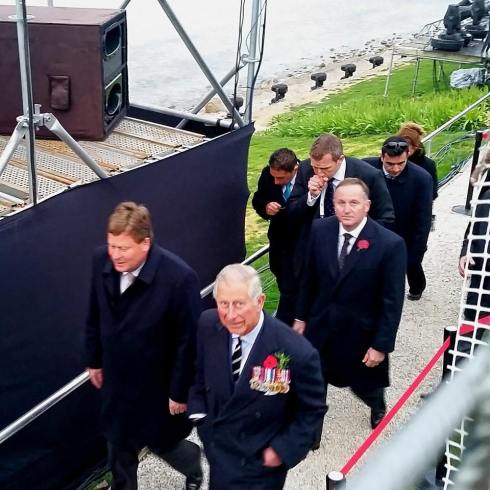
As the ceremony ends, we make our way, slowly, to Lone Pine, including past the Beach Cemetery where we pause across the many graves, including John Simpson’s. It’s not lost on us that the many graves are just a fraction of the people who died here, and many did not get buried; their bodies lie among us.

The walk to Lone Pine is long, steep, and dusty. Soon we have views right out across the ocean, but the trees surround us and it’s difficult to see where the path will take us. Despite being given four hours to get from ANZAC Cove to Lone Pine, time becomes increasingly short because of the security check hold up at the gates to Lone Pine and we arrive with 10 minutes to spare. Our Kiwi mates head on past us to their own service at Chunuk Bair.
I duck to the bathroom before heading into the site and am surrounded by no seats left in my designated division as well as a crush of people trying to meet Prince Harry, who’s standing in the middle of the cemetery. Eventually I find a seat seconds before the service begins. It’s as equally moving as the Dawn Service. I’m not alone in shedding tears.

Doug Bethune remains present in my mind and at the conclusion of the ceremony, I try to find him. I’m not sure where to start and circle the graves to see if anything sticks out, before using precious mobile data to visit the Commonwealth War Graves Commission to learn more.
It directs me away from the graves and towards the Lone Pine Memorial. And it’s there I find him.

Lest we forget.
The wait after is just as long as the wait to get in. New Zealand holds their ceremony after ours, and the buses do not begin to leave until an hour after it finishes. Clouds set in, it’s cold and blustery, and there is no food or drink. Some have been awake for more than 36 hours. Some complain. And yet we have just a few hours of these conditions, compared to months and years. And we get to leave, when so many did not.
I will take the experience with me forever.
Lest we forget.
My Dad’s Burrito Beef recipe
31 Mar
BACK STORY*
* This first part is very lengthy. If you’d prefer to skip to the actual recipe, it’s under the heading “RECIPE” if you scroll down.
As an only child growing up, I was prone to catastrophising – both generally (it is an excellent way to get attention), and in particular about my parents. As I grew older, and especially after I went away to boarding school at 13 and later to uni 1000km away from home, I realised how much they meant to me – and what that brought with it was, “What if they die?”
When I was staying at home in the school or uni holidays, if they went out to a barbecue (I was too cool to go with them, obviously) having said they’d be back at 10pm and it was 10.05pm, I’d imagine every scenario of what might have happened to them. Once this had happened enough times and they came back safe and sound (usually at 10.08pm), this thought process became a superstition: if they weren’t home when I expected them (or it was a stormy night, or I didn’t know where they were), the key thing I obviously needed to do was imagine every possible bad scenario, and some part of me knew that by doing this they’d come home safe and sound. (I realise how silly this sounds!) It was like imagining the most frightening scenarios was a guarantee that nothing bad would ever happen.
And it didn’t, for a while at least. Despite regularly driving the dark road between Rockhampton and Yeppoon, travelling the world, and attending those damn barbecues, they always came home perfectly fine.
Regardless, I never took saying goodbye to my parents for granted. In my late teens, Dad and I had a rare argument one night. He started work at 5am so went to bed early before I had the chance to properly rue my choice of words. I couldn’t bear the thought of the small chance of something happening to him while we were at odds, so popped a short note in his lunchbox that night – and he discovered it the next morning and wrote me a reply. Neither of us ever spoke about it, but 10 years later I still have his sweet reply.
When I said goodbye to my parents last year after they visited over Easter, I carefully remembered and valued each hug – as always, I figured there was a chance they could be my last. They weren’t my last, but they turned out to be the last I’d have before our lives were turned upside down five weeks later with dad’s terminal cancer diagnosis. For all my obsessive catastrophising, no only child superstitions prepared me for it, nor his death in August.
Dad’s cancer worsened rapidly, but I had three weekends where he was fully lucid and the first of those it was hard to believe he was even sick. On that weekend, we made burritos. My parents had owned and managed all aspects of a Cairns Mexican restaurant called Mexican Pete’s when I was born in the mid-1980s, and, around the time I was 10 – long after they’d sold it and we’d moved three towns by then – Dad started occasionally putting burritos on the weekend dinner menu, using the recipe they’d used at the restaurant. It became my favourite meal and something I always asked for when visiting home. So, on that first weekend home after the diagnosis, I pulled out the camera and recorded a video as Dad made it. We enjoyed a very normal, tasty meal.
The video of him making it, and making it since myself, has been a great source of comfort to me. It doesn’t bring him back, but he doesn’t feel so far away.
It’s also delicious (and easy), so I want to share it with you.
RECIPE
NB: Now. I know what you’re thinking. I am the self-proclaimed most hopeless cook ever. I’ve used salt instead of sugar in pancakes. I’ve poured burnt toffee into a kitchen sink. (I really do not recommend this. But if you’re looking to strengthen your chiseling skills, give it a whirl.) However, I’ve made this dish four or five times in the last few months and I’m pretty convinced that it’s hard to stuff up.
NB x 2: I have never done a recipe post before. And this is not in any way technical. If you spot something wrong or missing, please tell me!
Ingredients:
- TIME. This recipe doesn’t require much from you, but it does require time. Don’t start it at 7pm for a dinner that you want to serve that night. I think best started at 2pm.
- 1.2kg of chuck steak or gravy beef, diced. I can’t guarantee finding this at Coles or Woolies, but both are always available at the Belconnen Fresh Food Markets. What Dad told me is that it doesn’t really matter which one you get – just go for what has a bit more marbling (or is cheaper!). However, I’ve found gravy beef to be much better than chuck steak.
- 1 large onion, chopped
- 2 small green capsicums, also chopped
- 2 tablespoons soy sauce
- 2 heaped tablespoons of tomato paste (I actually think just use all of one of those little tubs they come in because it’s about the same)
- 2 teaspoons cumin
- 2 teaspoons ground black pepper
- 1 teaspoon cayenne pepper
- 2 teaspoons dry mustard
Method:
- Chop your gravy beef, onion and capsicums.
Ignore pleading whippet who is keen for off-cuts. - Put it all in a saucepan (one where you always know where the lid is so you don’t waste time trying to find it). No oil. No butter. No pre-heating. Nothing. Just put it all in and mix it around a bit so the three ingredients are mixed in together.
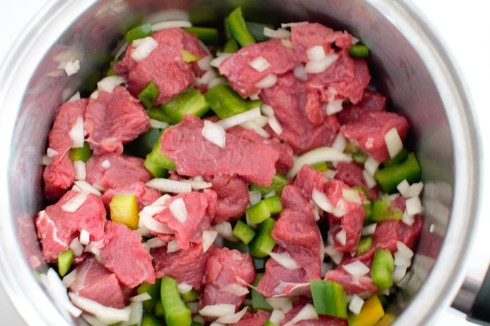
- Put the saucepan on low (LOW) heat. By LOW I mean on the lowest setting, or halfway between the lowest and second lowest. Put the lid on.
- Resist the temptation to lift the lid for two-three (!) hours. Cooking is not my forte as you all know, but the low heat draws out the juices from all the ingredients and the steam does a lot to help, too. There ends up being stacks and stacks of liquid, and this is what you want. All of the juice and flavour of the onion and capsicums do a lot to seep in to the beef, leaving just the very soft mushy membrane of the vegies.
- After a minimum two hours (I think three is best), lift the lid. There should be lots of liquid and it might be bubbling slightly. Depending on the beef and the temperature, it may need a bit longer than three hours. Drain the liquid stock – leaving just a little in the saucepan – and put it aside.

At first stir, it should look like this. Starting to loosen up a little.
- This is the hardest part for me to explain. Between this and the final step, the meat should start to shred. Sometimes I drain the stock and it really doesn’t look like it’s going to shred, but it miraculously does – and sometimes it doesn’t. What I do know is that you must use a wooden spoon if you’re going to have any luck. Stir the meat a little to loosen it up.
- Add the rest of the ingredients in the ingredients list (taking careful note of the difference between teaspoon and tablespoon). The key is restraint – you can always add more, but if you add in too much soy sauce (uh, for example), it might be hard to recover.
- Stir more! And more. It should start to really shred well so that you have very few chunks and much more shredded beef.

Starting to look okay in terms of shredding
- Add a little of the stock back if you need to – it should be very moist without being drippy. Otherwise, use the stock for something else (I have recently used it in a risotto and it was great).
And that is it. Serve it with shredded lettuce, chopped tomato, Old El Paso medium taco sauce, grated cheese, sour cream and guacamole (which I make with one avocado and one tablespoon of sour cream, with a big squeeze of lemon, and salt and pepper). Don’t overfill your tortilla!
It makes enough for 4-6, depending on appetites. For two of us, it’s usually two or three meals. The beef freezes well, especially if put in the freezer in small portions.

Correct way to fill a tortilla, in my opinion.

